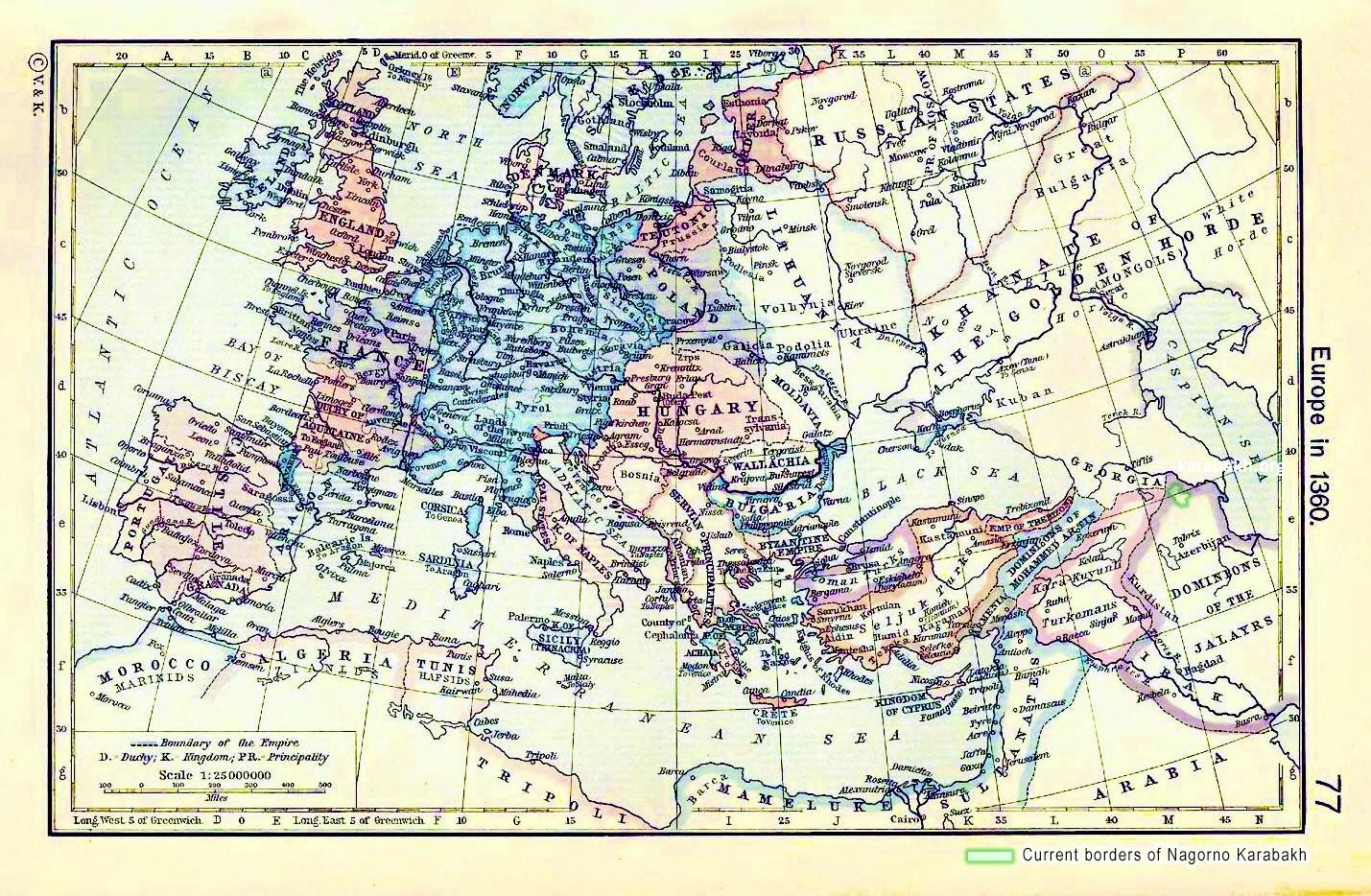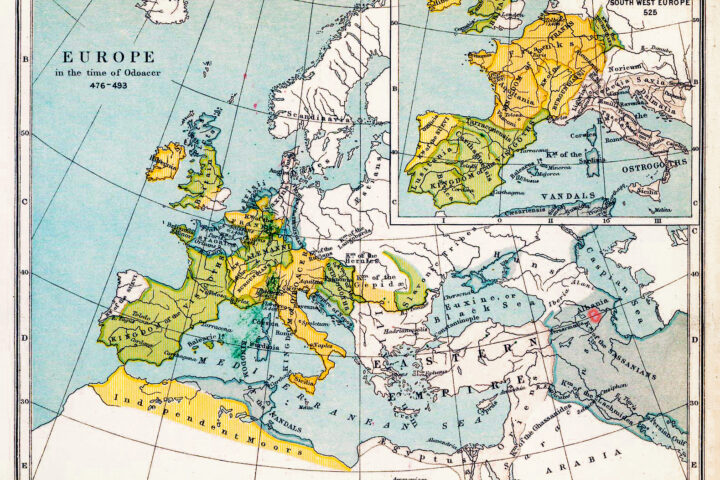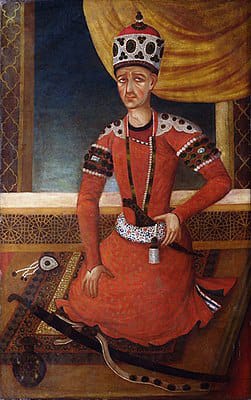About the ethnic composition of the inhabitants of Karabakh it is necessary to note the following: According to the academician Z. M. Buniyatov the inhabitants of Arran were Turkic language people already by the Mongol assault in the XIII century. (16) As is clear from the XIII century work Ajaib ad-dunya the main ethnic body in Arran was Turkic people and this territory ‘was under Muslim power’. Further we read there: ‘If the Turks of Arran are gathered in one place – it will resemble an assemblage of ants and locusts’. (17) As is known, in the period of the Mongol campaigns in the middle of the XIII century, some Mongol-Tatar tribes appeared and settled in Azerbaijan, including in Karabakh. The toponyms Higher and Lower Garkhun (in Yevlakh), Bozalganli (in Tovuz), Damgali (in Aghdara), Dolanlar (in Khojavand), Gurgan (in Fizuli), Ganlikand (in Kalbajar), Tatar (in Gubadli), Tatarli (in Shamkir) and Khachindorbatli (in Aghdam) are linked to them.
At the same time, the Albanian tribes, the majority of which dwelled in the mountainous part of Karabakh and in particular the Khachen Principality, occupied a definite place in the composition of the inhabitants of Karabakh, as before.
In the whole extensive history of the territory of Karabakh, Arran and Caucasian Albania in general, it was the object of strange claims. In this respect the Armenian historical map dedicated to the period of the later Middle Ages attracts attention. So, the map Armenia and Neighbouring Countries in 701-862, published in 1982 in Yerevan by S. G. Yeremian, is a clear example of territorial claims by Armenians on the history and territory of Azerbaijan.
On this map the whole territory of Caucasian Albania as well as the south eastern lands around the Black Sea and adjoining Lake Urmiya are marked as ‘Armenia’. This gives the false impression that at the Arab conquest of Caucasian Albania these lands were given to the Armenians. In reality, with the capture by the Arabs of the whole of Azerbaijan, it was included within the Arab Caliphate as one of its vilayets (provinces).
However, regardless of this, Armenian claims on Azerbaijani lands are reflected in numerous historical maps of the Arab period as well as later, including the XIII-XIV centuries, published by them. So, B. A. Arutyunian included a considerable part of Turkey, starting approximately from Sivas to Karabakh (surprisingly, Karabakh is not included) in the mythical Armenia on the map Wars of the Caucasian Peoples with the Invasion of Timur in the XIV-beginning of XV Centuries (Transcaucasia) (Yerevan, 1981-1982). The given sources counterbalance these mythological opinions of Armenians and provide evidence that Armenia did not have any relation, not only to Karabakh, but to Arran.
We draw attention to the facts. According to information given by Hamdullah Gazvini ‘the region of Armen is divided into two parts: ‘Greater Armenia’ and ‘Lesser Armenia’. ‘Lesser Armenia’ does not belong within the structure of Iran. Greater Armenia belongs within the structure of Iran (i.e. is found on the border of the Hulagid State – V.P.) and according to the administrative division into tyumens, it is known as the Akhlat tyumen, the limits of which extended to ‘Lesser Armenia’, Rum, Diyarbakr, Kurdistan, Azerbaijan and Arran. Its centre was the city of Aklat. The income of its divan is formed of 39 tyumans’. (18) Further down in the same work we read: ‘The Province of Arran – this is the land between two rivers, namely the Araz and the Kura’; ‘The Provinces of Arran and Mughan border Armen’ (19); ‘The length and breadth of Arran are approximately 30 and 40 farsakhs (i.e. 210 and 280 km – V.P.). They say that the Kura before the Araz flows [into it] within the borders of Arran’ (20); ‘There lies a large country of the name Arran… its western neighbour is Armenia’ (21); ‘Lake Goycha Tangiz lies on the border of Azerbaijan with Armenia’. (22)
Thus, the given neutral sources are a weighty and proven answer to Armenian claims to the primordial Azerbaijani lands. It becomes clear that the adjective ‘Greater’ relates to a small region of Armen, situated to the west of Azerbaijan and its component part Arran. This small region, a single tyumen called Akhlat, which formed part of the Hulagid State, at the same times as the single province of Azerbaijan (historical Atropathene) had 9 tyumens.
Armenians, along with territorial claims, also promotes the groundless claim that the people of Arran Karabakh from an ethnic point of view were Armenian and that Armenians formed the largest part of the population of the region. By so doing they try to appropriate Albanian culture. One of the means which Armenian apologetics resort to in their claims on the primordial Azerbaijani lands is also that the Christian Albanian population of Karabakh is Armenian.
The unscientific nature of this idea can be traced in the work of the XII century Albanian author Kirakos of Gandzak who considers the Albanian people separate from the Armenians. He speaks of ‘Armenians, Georgians and Agvans’ and Albania is not mixed with Armenia.
In the XIII-XIV centuries Karabakh was a region situated in the centre of Arran and included the mountainous and the plains territories and it did not bear any relation to the Armenians, and its Christian population was Albanian in origin.
All the foregoing gives grounds to confirm that Karabakh, as earlier, so in the centuries discussed by us, was ‘the soul of Azerbaijan’.
Sources:
1. Grekov, B. Yakubovsky, A. Золотая Орда. (The Golden Horde), Leningrad, 1937, p. 55.
2. Abu Bakr al-Kutbi al-Akhari. Tarikh-I Skeykh Uvyes. Baku, 1984, p.132
3. Geybullayev G.A. Топонимия Азербайджана. (Toponyms of Azerbaijan), Baku, 1986, p. 145
4. Sharaf-ad-din Ali Yazdi. Zafarname. Tashkent, 1972 (in Persian), p. 182
5. Abu Bakr al-Kutbi al-Akhari, Tarikh-I Skeykh Uvyes. Baku, 1984, p.132
6. Yakut-al-Khamavi, Mujam al-Buldan; Hamdullah Gazvini, Nuzkhatal-kulub,Baku,1983,p.56
7. Sharaf-khan ibn Shamsaddin Bidlisi, Sharaf-name, Volume 1. M., Nauka, 1967, p.534
8. Abbas-Gulu-Agha Bakixhanov. Gulustan-i Iram. Baku, 1991, p.203
9. Yakut-al-Khamavi, Mujam al-Buldan; Hamdullah Gazvini, Nuzkhatal-kulub. Baku, 1983,p.56
10. Rashid-ad-din. Correspondence. Moscow, Nauka, 1971, p.270
11. Rashid-ad-din Fazlullah Khamadani. Asar va akhya, Tehran. 1336 (in Persian), p.46
12. Piriyev V.Z. Азербайджан в XIII-XIV веках. (Azerbaijan in XIII-XIV centuries). Baku, 2003 (in Azerbaijani), p. 97-109.
13. Yesai Hasan-Jalal. Краткая история страны Албанской (1702-1722 годы) (A Short History of Albanian Country (1702-1722). Baku, 1989, p. 6
14. Orbeli I.A. Хасан-Джалал, князь Хачинский. (HasanJalal, Prince of Khachen) Selected works. Yerevan,1963,p.146-161
15. Yakut-al-Khamavi, Mujam alBuldan; Hamdullah Gazvini, Nuzkhat-al-kulub, Baku,1983, p.56-57
16. Buniyatov Z.M. Несколько замечаний по поводу этнических процессов в Ширване. (до первой трети XIII века). (A few remarks about ethnical processes in Shirvan (until the first third of the XIII century). Reports of Azerbaijan National Academy of Sciences, 1986, No.4
17. Shikhab-ad-din Muhammad an-Nasavi, Жизнеописание Султана Джалал-ад-дина Манкбурны (Biography of Sultan Jalal-ad-din Mankburn), Baku, 1973, p. 274
18. Hamdullah Mustovfi Gazvini. Nuzkhat-al-kulub. Tehran, 1336, (in Persian) p.117
19. Yakut-al-Khamavi, Mujam alBuldan; Hamdullah Gazvini, Nuzkhat-al-kulub,Baku,1983, p.52-53
20. Miklouho-Maclay M.D. Географическое сочинение XIII века на персидском языке. (Geographical Work of the XIII Century in Persian) Scientific writings IV AN USSR, v.X Moscow-Leningrad, 1954, p. 175-219
21. Johannes de Galonifontibus. Сведения о народах Кавказа (1404 год). Information about the People of the Caucasus (1404). Baku, 1980, p. 42
22. Yakut-al-Khamavi, Mujam alBuldan; Hamdullah Gazvini, Nuzkhat-al-kulub,Baku, 1983, p.62








